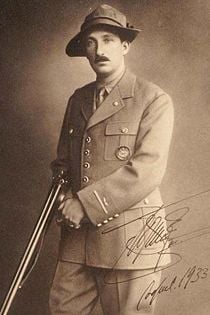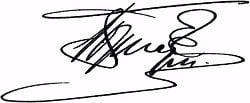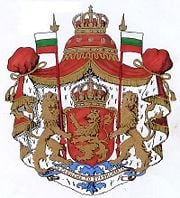Difference between revisions of "Boris III of Bulgaria" - New World Encyclopedia
(fix) |
|||
| Line 26: | Line 26: | ||
Boris III was the first son of [[Ferdinand I of Bulgaria|Ferdinand I]], Tsar of Bulgaria and Princess [[Marie Louise of Bourbon-Parma]], the eldest daughter of Robert I, Duke of Parma and Princess Maria Pia of Bourbon-Two Sicilies. | Boris III was the first son of [[Ferdinand I of Bulgaria|Ferdinand I]], Tsar of Bulgaria and Princess [[Marie Louise of Bourbon-Parma]], the eldest daughter of Robert I, Duke of Parma and Princess Maria Pia of Bourbon-Two Sicilies. | ||
| − | Ferdinand was a prince of the [[Kohary]] branch of the ducal family of [[Saxe-Coburg-Gotha]]. He grew up in the cosmopolitan environment of [[Austro-Hungarian]] high [[nobility]] and also in their ancestral lands in [[Slovakia]] and in [[Germany]]. The Kohary, descending from a noble [[Slovaks|Slovak]] family of [[Hungary]], were quite wealthy, holding the princely lands of [[Čabrad]] and [[Sitno]], in what is now | + | Ferdinand was a prince of the [[Kohary]] branch of the ducal family of [[Saxe-Coburg-Gotha]]. He grew up in the cosmopolitan environment of [[Austro-Hungarian]] high [[nobility]] and also in their ancestral lands in [[Slovakia]] and in [[Germany]]. The Kohary, descending from a noble [[Slovaks|Slovak]] family of [[Hungary]], were quite wealthy, holding the princely lands of [[Čabrad]] and [[Sitno]], in what is now Slovakia. |
Ferdinand was the son of [[Prince August of Saxe-Coburg and Gotha|Prince August of Saxe-Coburg]] and his wife [[Clémentine of Orléans]], daughter of king [[Louis Philippe I of the French]], and grand-nephew of [[Ernst I of Saxe-Coburg-Gotha|Ernest I]], Duke of [[Saxe-Coburg-Gotha]] and of [[Leopold I of Belgium|Leopold I]], first king of the Belgians. | Ferdinand was the son of [[Prince August of Saxe-Coburg and Gotha|Prince August of Saxe-Coburg]] and his wife [[Clémentine of Orléans]], daughter of king [[Louis Philippe I of the French]], and grand-nephew of [[Ernst I of Saxe-Coburg-Gotha|Ernest I]], Duke of [[Saxe-Coburg-Gotha]] and of [[Leopold I of Belgium|Leopold I]], first king of the Belgians. | ||
Revision as of 05:49, 9 February 2009
Boris III, Tsar of Bulgaria (January 30, 1894 – August 28, 1943), originally Boris Klemens Robert Maria Pius Ludwig Stanislaus Xaver (Boris Clement Robert Mary Pius Louis Stanislaus Xavier), son of Ferdinand I, came to the throne in 1918 upon the abdication of his father, following Bulgaria's defeat in World War I. This was the country's second major defeat in only five years, after the disastrous Second Balkan War (1913). Under the Treaty of Neuilly, Bulgaria was forced to cede new territories and pay crippling reparations to its neighbors, thereby threatening political and economic stability. Two political forces, the Agrarian Union and the Communist Party, were calling for the overthrowing of the monarchy and the change of the government. It was in these circumstances that Boris succeeded to the throne.
Lineage
Boris III was the first son of Ferdinand I, Tsar of Bulgaria and Princess Marie Louise of Bourbon-Parma, the eldest daughter of Robert I, Duke of Parma and Princess Maria Pia of Bourbon-Two Sicilies.
Ferdinand was a prince of the Kohary branch of the ducal family of Saxe-Coburg-Gotha. He grew up in the cosmopolitan environment of Austro-Hungarian high nobility and also in their ancestral lands in Slovakia and in Germany. The Kohary, descending from a noble Slovak family of Hungary, were quite wealthy, holding the princely lands of Čabrad and Sitno, in what is now Slovakia.
Ferdinand was the son of Prince August of Saxe-Coburg and his wife Clémentine of Orléans, daughter of king Louis Philippe I of the French, and grand-nephew of Ernest I, Duke of Saxe-Coburg-Gotha and of Leopold I, first king of the Belgians.
Early reign
One year after Boris's accession, Aleksandar Stamboliyski (or Stambolijski) of the Bulgarian People's Agrarian Union was elected prime minister. Though popular with the large peasant class, Stambolijski earned the animosity of the middle class and military, which led to his toppling in a military coup on 9 June 1923. In 1925, there was a short border war with Greece, known as the Incident at Petrich, which was resolved with the help of the League of Nations. Also in 1925, there were two attempts on Boris's life perpetrated by leftist extremists. After the second attempt, the military in power exterminated in reprisals several thousand communists and agrarians including representatives of the intelligentsia.
In the coup on May 19, 1934, the Zveno military organization established a dictatorship and abolished the political parties in Bulgaria. King Boris was reduced to the status of a puppet king as a result of the coup.[1] In the following year, he staged a counter-coup and assumed control of the country by establishing a regime loyal to him. The political process was controlled by the Tsar, but a form of parliamentary rule was re-introduced, without the restoration of the political parties.[2]
Boris married Giovanna of Italy, daughter of Victor Emmanuel III of Italy, first in Assisi in October 1930 (attended by Benito Mussolini), and then at an Orthodox ceremony in Sofia. The marriage produced a daughter, Maria Louisa, in January 1933, and a son and heir to the throne, Simeon, in 1937. Tsar Boris was on the front cover of the Time Magazine of 20 January 1941 wearing full military uniform.
World War II
In the early days of World War II, Bulgaria was neutral, but powerful groups in the country swayed its politics toward Germany (whom they had also allied with in World War I), which had gained initial sympathies by forcing Romania to cede southern Dobruja back to Bulgaria. In 1941, Boris reluctantly allied himself with the Axis Powers in an attempt to recover Macedonia from Greece and Yugoslavia, which had been gained by Bulgaria in the First Balkan War and lost again in the Second.
| ||||||||||||||||||||||||||||||||
However, in spite of this loose alliance, Boris was not willing to render full and unconditional cooperation with Germany, and the only German presence in Bulgaria was along the railway line which passed through it to Greece.
In early 1943, Nazi officials requested that Bulgaria send its Jewish population to German occupied Poland. The request caused a public outcry, and a campaign whose most prominent leaders were Parliament Vice-Chairman Dimitar Peshev and the head of the Bulgarian Orthodox Church, Archbishop Stefan, was organized.[3] Following this campaign Boris refused to permit the extradition of Bulgaria's 50,000 Jews. Nonetheless, he did sanction the German demand for the extradition of 11,343 Jews from those territories re-occupied by Bulgaria. These two decisions resulted in large numbers of people regarding Boris as a hero for 'saving' Bulgaria's Jews, while large numbers revile him for condemning those of the occupied territories. The extent to which the Tsar was able to influence events in either case remains a matter of debate.
Most irritating for Hitler, however, was the Tsar's refusal to declare war on the Soviet Union or send Bulgarian troops to the Eastern front. On the 9 August 1943, Hitler summoned Boris to a stormy meeting at Rastenburg, East Prussia, where Tsar Boris arrived by plane from Vrajdebna on Saturday 14 August. While Bulgaria had declared a 'symbolic' war on the distant United Kingdom and the United States, at that meeting Boris once again refused to get involved in the war against the Soviet Union. Boris was unwilling to send troops to Russia because many ordinary Bulgarians had strong Russophile sentiments for their Slavic brethern, and the political and military position of Turkey remained unclear. The 'symbolic' war against the Western Allies, however, turned into a disaster for the citizens of Sofia in 1943 and 1944 as the city was heavily bombarded by the United States Air Force and the British Royal Air Force.
Death
Shortly after returning to Sofia, Boris died of apparent heart failure on 28 August 1943.[4] He had complained of chest pains for some months and had put it down to angina. Conspiracy theories instantly sprang up, many choosing to believe that he was poisoned by Hitler in an attempt to put a more obedient government in place. The evening before the illness occurred, Boris had an official dinner in the Italian embassy. Others suggest that his death was a Communist plot to destabilize the monarchy, and that Boris was poisoned while visiting the Rila Monastery before getting ill. The question has never been settled and many people remain of the belief that Boris was murdered, in spite of any corroborating evidence. Boris was succeeded by his six-year-old son Simeon II under a Regency Council headed by his brother, Prince Kyril of Bulgaria.
Following a large and impressive State Funeral at the Alexander Nevsky Cathedral, Sofia, where the streets were lined with weeping crowds, the coffin of Tsar Boris III was taken by train to the mountains and buried in Bulgaria's largest and most important monastery, the Rila Monastery.
Legacy
After taking power in September 1944, the Communist-dominated government had his body exhumed and secretly buried in the courtyard of the Vrana Palace near Sofia. At a later time the Communist authorities removed the zinc coffin from Vrana and moved it to a secret location, which remains unknown to this day. After the fall of communism, an excavation attempt was made at the Vrana Palace, in which only Boris's heart was found, as it had been put in a glass cylinder outside the coffin. The heart was taken by his widow in 1993 to Rila Monastery where it was reinterred.
Ancestors
| Ancestors of Boris III of Bulgaria | |||||||||||||||||||||||||||||||||||||||||||||||||||||||||||||||||||||||||||||||||||||||||||||||||||||||||||||||||||||||||||||||||||||||||||||||||||||||||||||||||||||||||||||||||||||||||||||||||||||||||||||||||||||||||||||||||||||||||||||||||||||||||||||||||||||||||||||||||||||||||||||||||||||||||||||||||||||||||||||||||||||||||||||||||||||||||||||||||||||||||||||||||||||||||||||||||||||||||||||||||||||||||||||||||||||||||||||||||||||||||||||||||||||||||||||||||||||||||||||||||||||||||||||||||||||||||||||||||||||||||||||||||||||||||||||||||
|---|---|---|---|---|---|---|---|---|---|---|---|---|---|---|---|---|---|---|---|---|---|---|---|---|---|---|---|---|---|---|---|---|---|---|---|---|---|---|---|---|---|---|---|---|---|---|---|---|---|---|---|---|---|---|---|---|---|---|---|---|---|---|---|---|---|---|---|---|---|---|---|---|---|---|---|---|---|---|---|---|---|---|---|---|---|---|---|---|---|---|---|---|---|---|---|---|---|---|---|---|---|---|---|---|---|---|---|---|---|---|---|---|---|---|---|---|---|---|---|---|---|---|---|---|---|---|---|---|---|---|---|---|---|---|---|---|---|---|---|---|---|---|---|---|---|---|---|---|---|---|---|---|---|---|---|---|---|---|---|---|---|---|---|---|---|---|---|---|---|---|---|---|---|---|---|---|---|---|---|---|---|---|---|---|---|---|---|---|---|---|---|---|---|---|---|---|---|---|---|---|---|---|---|---|---|---|---|---|---|---|---|---|---|---|---|---|---|---|---|---|---|---|---|---|---|---|---|---|---|---|---|---|---|---|---|---|---|---|---|---|---|---|---|---|---|---|---|---|---|---|---|---|---|---|---|---|---|---|---|---|---|---|---|---|---|---|---|---|---|---|---|---|---|---|---|---|---|---|---|---|---|---|---|---|---|---|---|---|---|---|---|---|---|---|---|---|---|---|---|---|---|---|---|---|---|---|---|---|---|---|---|---|---|---|---|---|---|---|---|---|---|---|---|---|---|---|---|---|---|---|---|---|---|---|---|---|---|---|---|---|---|---|---|---|---|---|---|---|---|---|---|---|---|---|---|---|---|---|---|---|---|---|---|---|---|---|---|---|---|---|---|---|---|---|---|---|---|---|---|---|---|---|---|---|---|---|---|---|---|---|---|---|---|---|---|---|---|---|---|---|---|---|---|---|---|---|---|---|---|---|---|---|---|---|---|---|---|---|---|---|---|---|---|---|---|---|---|---|---|---|---|---|---|---|---|---|---|---|---|---|---|---|---|---|---|---|---|---|---|---|---|---|---|---|---|---|---|---|---|---|---|---|---|---|---|---|---|---|---|---|---|---|---|---|---|---|---|---|---|---|---|---|---|---|---|---|---|---|---|---|---|---|---|---|---|---|---|---|---|---|---|---|---|---|---|---|---|---|---|---|---|---|---|---|---|---|---|---|---|---|---|---|---|---|---|---|---|---|---|---|---|---|---|---|---|---|---|---|---|---|---|---|---|---|---|
| |||||||||||||||||||||||||||||||||||||||||||||||||||||||||||||||||||||||||||||||||||||||||||||||||||||||||||||||||||||||||||||||||||||||||||||||||||||||||||||||||||||||||||||||||||||||||||||||||||||||||||||||||||||||||||||||||||||||||||||||||||||||||||||||||||||||||||||||||||||||||||||||||||||||||||||||||||||||||||||||||||||||||||||||||||||||||||||||||||||||||||||||||||||||||||||||||||||||||||||||||||||||||||||||||||||||||||||||||||||||||||||||||||||||||||||||||||||||||||||||||||||||||||||||||||||||||||||||||||||||||||||||||||||||||||||||||
See also
- History of Bulgaria
Notes
- ↑ "Tsar's Coup", Time Magazine, 1935-02-04. Retrieved 2008-08-10.
- ↑ Balkans and World War 1
- ↑ Balkans into Southeastern Europe, pg. 154
- ↑ "Bulgarian Rule Goes to Son, 6. Reports on 5-day Illness Conflict," United Press dispatch in a cutting from an unknown newspaper in the collection of historian James L. Cabot, Ludington, Michigan.
ReferencesISBN links support NWE through referral fees
- Bulgaria in the Second World War by Marshall Lee Miller, Stanford University Press, 1975.
- Boris III of Bulgaria 1894-1943, by Pashanko Dimitroff, London, 1986, ISBN 0-86332-140-2
- Crown of Thorns by Stephane Groueff, Lanham MD., and London, 1987, ISBN 0-8191-5778-3
- The Betrayal of Bulgaria by Gregory Lauder-Frost, Monarchist League Policy Paper, London, 1989.
- The Daily Telegraph, Obituary for "HM Queen Ioanna of the Bulgarians," London, 28 February 2000.
- Balkans into Southeastern Europe by John R. Lampe, Palgrave Macmillan, New York, 2006.
External links
| House of Saxe-Coburg and Gotha Cadet Branch of the House of Wettin Born: 30 January 1894; Died: 28 August 1943 | ||
|---|---|---|
| Regnal Titles
| ||
| Preceded by: Ferdinand I |
Tsar of Bulgaria 3 October 1918 – 28 August 1943 |
Succeeded by: Simeon II |
| ||||||||||||||||||||||
Credits
New World Encyclopedia writers and editors rewrote and completed the Wikipedia article in accordance with New World Encyclopedia standards. This article abides by terms of the Creative Commons CC-by-sa 3.0 License (CC-by-sa), which may be used and disseminated with proper attribution. Credit is due under the terms of this license that can reference both the New World Encyclopedia contributors and the selfless volunteer contributors of the Wikimedia Foundation. To cite this article click here for a list of acceptable citing formats.The history of earlier contributions by wikipedians is accessible to researchers here:
The history of this article since it was imported to New World Encyclopedia:
Note: Some restrictions may apply to use of individual images which are separately licensed.



